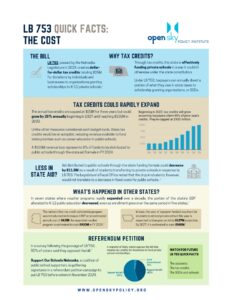After repeated attempts to pass school privatization measures had failed, Nebraska lawmakers in 2023 approved LB 753, which creates dollar-for-dollar tax credits totaling up to $100 million for donations by individuals and businesses to organizations granting private school scholarships.

Tax credits could expand to $100M
Beginning in 2024, taxpayers can annually divert a portion of what they owe in state taxes to scholarship granting organizations, or SGOs, which in turn would award scholarships to eligible students attending a private school. This mechanism, set out in LB 753, provides an avenue for the state to fund private schools in a way it couldn’t otherwise under the state constitution that prohibits appropriations to non-public schools.
The annual tax credits are capped at $25 million for three years but could grow by 25% annually beginning in 2027 until reaching $100 million in 2033. The tax credits are an offset of what an individual, business or estate owes the state, reducing what flows into Nebraska’s bank account. When revenue shrinks, the state has less money to spend on priorities in K-12 education such as addressing the teacher shortage or investing in career education programs that are key to developing more skilled workers. Fewer dollars flowing in means less money going out in other areas, as more than 90% of the state’s General Fund budget goes to fund education, health and human services and public safety.
Funding formula influenced
In its analysis of LB 753, the Legislative Fiscal Office provided an example of how the bill could lead to a decrease in state aid distributed to public schools. If 5,000 students were to shift from the state’s largest public school districts to private schools, calculations within the TEEOSA formula, which the state uses to allocate funds to school districts, could result in $11.8 million less going to public K-12 education. The Legislature’s Fiscal Office noted, too, that the drop in students would not translate to a decrease in costs unless a large number of the transfers left the same public school.
The Legislature this year committed to providing $305 million in additional K-12 education funding through LB 583, which created foundation aid of $1,500 per student and increased reimbursement of special education costs to 80% for districts. The additional state aid will come from the Education Future Fund established this year with an initial $1 billion investment. But separate legislation, LB 243, tied most of the increase in state aid that districts receive to a decrease in property taxes. As a result, this new approach to education funding doesn’t represent a significant increase in overall funding for public schools.
In a survey this spring, nearly half of Nebraska voters (49%) said public schools need more resources than they have right now in order to provide children with a quality education. Only 12% said public schools can continue to provide a quality education with fewer resources.
Programs grow in other states
In 1997, Arizona became the first state to approve private school scholarship tax credits. From an initial annual cost of $4.5 million, Arizona is expected to commit $900 million to its expanded voucher program this year. There are numerous other examples of states where an initial school privatization program has grown into something larger.
A recent study of programs in seven states documents how state voucher spending from 2008 to 2019 increased by hundreds of millions of dollars annually, while spending for K-12 public education declined despite enrollment increases. In Georgia, what the state spent on two voucher programs grew from $11.1 million to $109 million, an 883% increase from 2009 to 2019. During that same period, per-pupil funding for public education in Georgia fell by 1.9%.
Signature-gathering effort continues
Support Our Schools Nebraska, a coalition of public school supporters, is gathering signatures in a referendum petition campaign to put LB 753 before voters in November 2024.
More on LB 753 to come at openskypolicy.org.

